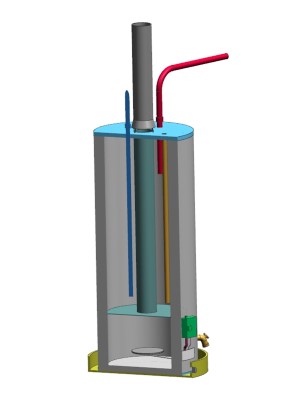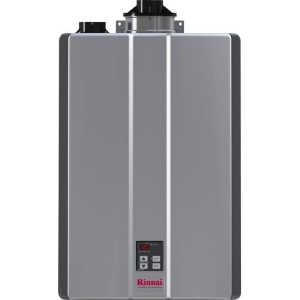- Home
- Water Tank Heater
- Hot Water Heater Maintenance
Hot Water Heater Maintenance Guide and Tips
DIY hot water heater maintenance and service guide for efficient water heating and longer unit life. Find out which elements have to be maintained, how and how often. Go through the checklist for the best results. The article covers both electric and gas-powered heaters.
Keep in mind that a properly installed water heater brings years of reliable, dependable, and safe water heating. As with any other device, the unit may require preventive maintenance and occasional repair.
Hot water heater maintenance should be done per manufacturer's instructions and performed by the licensed technician, but for those looking to save, simple maintenance procedures and tips are listed below as the DIY project.
Water heater maintenance checklist
- Check the anode rod
- Check and test the drain valve
- Check the vents and flue baffle
- Test the TPR valve
- Check the thermocouple
- Check the igniter
- Check the gas burner
- Check the heating elements
- Clean the arrestor plate
- Check the gas valve
The importance of water heater maintenance
- Increases efficiency and performance
- Lowers energy bills, saving you money, time, and resources
- Extend the life of a water heater
- Ensures safe working conditions
- Maintains the comfort
Signs that show your water heater needs maintenance
- Discolored water (rusty, milky)
- Smell (rotten egg)
- Takes long to heat up water
- No hot water
- Lukewarm water
- Noise
- Sooting
- Leak
- Yellow flame
Water heater maintenance guide
Gas water heaters are a more complex than the electric ones, so they require more effort and time to keep them clean and operational. Gas type models utilize gas pipes, venting systems, gas burner, ignition systems, and other elements that have to work all the time to provide a reliable supply of hot water.
Also, both types are affected by water quality or chemistry. For example, from the sediment build-up, a gas burner and heating elements will both suffer. The performance will be reduced, and heating won't be efficient. Also, the anode rod and dip tube could deteriorate, get weaken over time, and resulting in a "no hot water" problem.
- Find Plumbers In Your Area -
Recommended tools for the maintenance
- Multimeter
- Screwdrivers
- Pliers
- Gas pressure gauge
- Water pressure gauge
- Tubing cutter
- Garden hose
- Bucket
- Teflon tape
- Sandpaper or steel wool
Arrestor plate and base filter
 Gas water heater
Gas water heaterIf your gas water heater is installed in a dirty environment with an excessive amount of dirt, lint, and dust, you should vacuum the base of the heater and clean its elements more often than recommended.
It is imperative to maintain the arrestor and base filter clean so that the gas combustion chamber can get unobstructed airflow. The recommendation is to clean the base filter at least once a year.
Anode rod
The anode rod, which is used to protect the metal water heater tank from corrosion, deteriorates over time. Maintain the rod in a good state to keep the tank in operating condition longer. Replace the anode rod if depletion is 1/2 of the original rod diameter or steel core is exposed. Inspect the rod once a year.
Burner assembly
To clean the combustion chamber, including the main gas burner, pilot burner, and a thermocouple you should remove the burner assembly first. You can use the vacuum cleaner and stiff brush to remove all the debris and scale from the combustion chamber, burner surface, and burner ports.
A gas burner should be visually inspected for proper operation every six months. It should burn with a blue flame and some yellow color at the tip. After a minute of service, the burner should operate in radiant mode and glow bright orange.
If there is an insufficient combustion air supply, use the compressed air to clean the flame arrestor from the dirt accumulation.
Inspect the pilot orifice for any potential blockage. It must be cleaned or replaced if clogged. Check for the kinks or cracks in the pilot tube. The pilot must be replaced if damaged.
Piezoelectric igniter
When the igniter button is pressed, the electric spark is generated, which ignites the pilot light. The spark gap of 0.125" is factory set and should be maintained for the proper work. When inspecting the igniter, a visible spark should jump from the tip of the electrode while testing. Sometimes this igniter can be covered by dirt and rust, which would prevent the spark. Use the damp cloth and wipe it clean. Dry completely. If the rust is persistent, use the fine-grit sandpaper.
If the unit is equipped with the hot surface igniter, check the igniter current. The new one has a current in a range between 4 and 5 Amps. If it is below 3 Amps, replace it.
Flame sensor
If the water heater is equipped with the flame sensor, such as one found in AO Smith Vertex (GDHW-50) series, you might have an "ignition failure" problem. The problem is with the corroded flame sensor or accumulation of rust. Also, check for signs of cracks and damages of the insulator. The solution is to clean the sensor using the fine grade steel wool — this way the flame sensing current will get back to normal, which is between 8 and 12 µA.
Dip tube
A dip tube should also be inspected from time to time as the broken tube can cause the water heater to produce less hot water than expected, as it is diluting hot with cold water. Inspect the dip tube and look for possible cracks and deformation. If you find any, the element must be replaced.
Venting
An unobstructed venting system is essential for the safe operation of the water heater. Remove the draft hood and flue baffle once a year and clean the venting system from debris. Make sure that all the vent connectors are correctly positioned and securely attached. Look for the signs of sooting and deformation.
TPR valve
Check if the TPR valve (temperature and pressure relief valve) operates freely, at least once a year. Lift and release the handle on the TPR valve, located near the top of the unit and let the few gallons of water out through the discharge pipe to an open drain. If this safety valve, for some reason, cannot open and release the pressure, the water heater can deform due to the extreme build-up pressure, even explode.
Drain valve and flushing
Drain a few gallons of water every several months to remove or reduce sediments from the tank. The sediment build-up inside the tank and heater's elements can clog the plumbing lines and reduce the efficiency.
Heating elements
Check the heating elements for any limescale buildup, and scrape off any deposits.
Insulation
Check if the water heater loses heat. The heat that is lost through the unit's wall is called standby heat loss. Put your hand on the outer shell of the water heater, and if it is warm to the touch, the unit is losing heat, mainly due to thin insulation. You can fix this problem by installing the insulation blanket.
If the pipes are exposed to a lower temperature, use the foam pipe insulators for protection.
Check the water pressure
Operating water pressure of the water heater is around 50 PSI. If the pressure is higher, it can damage the heater and other home appliances. Check the water pressure at the drain valve and if it is higher than recommended, use the pressure reducing valve (PRV).
As the plumbing code requires installing the expansion tank in closed systems, make sure it works appropriately while performing the maintenance.
Gas and water leaks
Check the water heater and connections for water and gas leaks. Most of the time, water is leaking from the top or bottom and from the TPR valve, drain valve due to condensation, rusty tank, or loose connections. Identify the cause of the leak and either replace the bad element, gasket, or tighten the loose connection.
For the gas connections, use the mixture of water and soap, apply it, and if you see bubbles, you have a gas leak. This requires professional attention.
Summary
As seen from the above, the guide to the proper hot water heater maintenance is not complicated, and by following the recommendations from the manufacturers and professionals, it can provide years of trouble-free service. Regular maintenance and clean water heater are the first things that should be considered when troubleshooting the heaters.
And, remember, safety first. Before you start, always ensure that the gas, water, and electric supply are turned off (if needed). If you are not comfortable working on the water heater, always call a professional.
Related
- Home
- Water Tank Heater
- Hot Water Heater Maintenance



